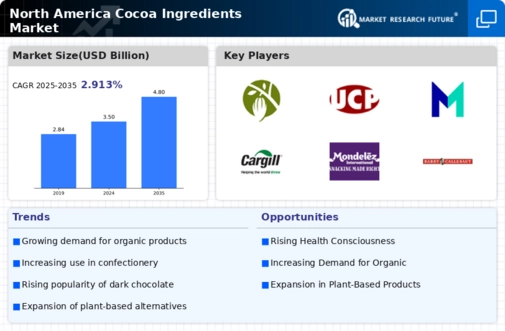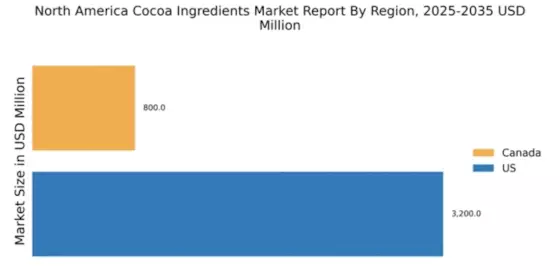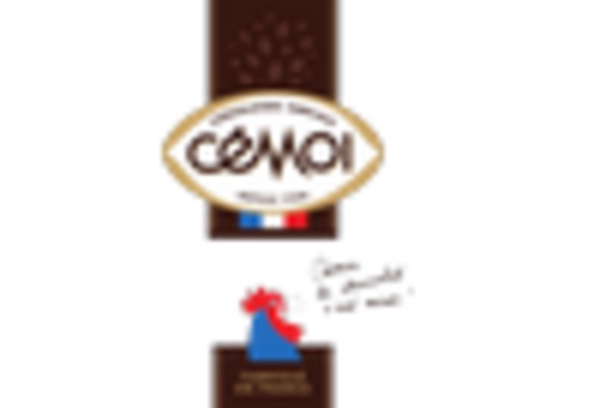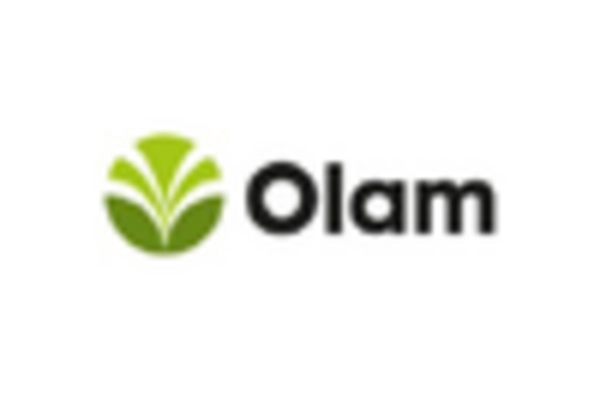Rising Demand for Dark Chocolate
The cocoa ingredients market in North America experiences a notable surge in demand for dark chocolate, driven by its perceived health benefits. Consumers increasingly favor dark chocolate due to its higher cocoa content and lower sugar levels, which align with health-conscious trends. Reports indicate that the dark chocolate segment is projected to grow at a CAGR of approximately 8% from 2025 to 2030. This shift in consumer preference is likely to influence the cocoa ingredients market, as manufacturers adapt their product offerings to meet this demand. The increasing incorporation of dark chocolate in various food products, including snacks and desserts, further propels this trend. As a result, the cocoa ingredients market is expected to witness significant growth, with companies investing in innovative formulations to cater to the evolving tastes of consumers.
Expansion of Plant-Based Products
The cocoa ingredients market in North America is significantly impacted by the rising trend of plant-based diets. As more consumers adopt vegetarian and vegan lifestyles, the demand for plant-based food products, including those containing cocoa, is on the rise. This shift is reflected in the increasing number of food manufacturers incorporating cocoa ingredients into plant-based alternatives, such as dairy-free chocolates and desserts. Market analysis suggests that the plant-based food sector is expected to grow by over 10% annually, creating new opportunities for cocoa ingredient suppliers. The cocoa ingredients market must adapt to this trend by developing innovative products that align with plant-based dietary preferences. This adaptation not only meets consumer demand but also positions companies favorably in a competitive market landscape.
Increased Use of Cocoa in Functional Foods
The cocoa ingredients market in North America is witnessing a growing trend towards the incorporation of cocoa in functional foods. As consumers become more health-conscious, they seek products that offer additional health benefits. Cocoa is recognized for its antioxidant properties and potential cardiovascular benefits, making it an attractive ingredient for functional food manufacturers. The market for functional foods is expected to grow by approximately 7% annually, creating opportunities for cocoa ingredient suppliers to develop products that align with this trend. The cocoa ingredients market is likely to benefit from this shift, as companies explore innovative ways to integrate cocoa into health-focused products, such as protein bars and fortified snacks. This trend not only enhances product appeal but also addresses the evolving preferences of health-oriented consumers.
Innovations in Cocoa Processing Techniques
Advancements in cocoa processing techniques are reshaping the cocoa ingredients market in North America. Innovations such as cold-pressing and advanced fermentation methods enhance the flavor profiles and nutritional value of cocoa products. These techniques allow manufacturers to produce high-quality cocoa ingredients that cater to the growing demand for premium products. The market for specialty cocoa ingredients is projected to expand, with an estimated growth rate of 6% annually. As consumers become more discerning about the quality of cocoa products, the cocoa ingredients market must invest in research and development to stay competitive. This focus on innovation not only improves product offerings but also addresses the increasing consumer interest in artisanal and gourmet cocoa products.
Growing Popularity of Cocoa-Based Beverages
The cocoa ingredients market in North America is experiencing a rise in the popularity of cocoa-based beverages, including hot chocolate and chocolate-flavored drinks. This trend is driven by consumer preferences for indulgent yet comforting beverages, particularly during colder months. Market Research Future indicates that the cocoa beverage segment is projected to grow at a CAGR of 5% from 2025 to 2030. The increasing availability of ready-to-drink cocoa beverages and the introduction of innovative flavors contribute to this growth. As consumers seek convenient and enjoyable beverage options, the cocoa ingredients market must adapt by offering diverse product lines that cater to these preferences. This adaptation not only meets consumer demand but also positions companies to capitalize on the expanding beverage market.


















Leave a Comment